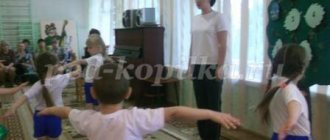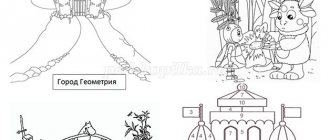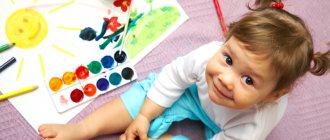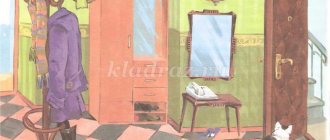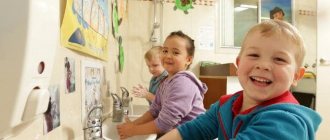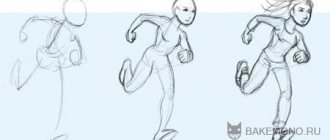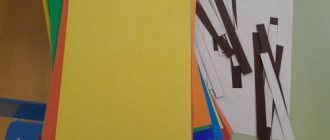Summary of a valeological lesson for the senior group.
Seeds of health. Your daily routine
A lesson in valeology for 5-6 year old students.
Purpose of the lesson:
formation of ideas about the daily routine, parts of the day and the need for a healthy lifestyle.
Objectives:
Educational: - consolidate students’ knowledge about the parts of the day;
— reveal the interdependence of a healthy lifestyle and adherence to a daily routine. Educational: - formation of a conscious attitude towards one’s health; — cultivate the ability to listen to each other, communicate, respect other people’s opinions; - foster a sense of collectivism. Developmental: - development of memory, attentiveness, coordination of movements; — development of the need for active manifestation of one’s “I” in communication with peers and adults. Materials:
multimedia presentation, screen, projector, laptop, recordings of the musical game “The Giraffe Has Spots, Spots...”, funny children's songs.
Vocabulary work:
valeology, daily routine, lullaby.
Preliminary work:
- analysis of proverbs and sayings about parts of the day.
Methods, techniques:
playful, visual, practical, verbal, artistic expression.
(Slide No. 1. A picture depicting a drawn daily routine is projected onto the screen) Presenter:
Hello, dear mothers and grandmothers!
Good morning, dear children! We are glad to see you in our hall for a lesson on valeology. Let's get acquainted with this word - valeology. Translated from Latin it means “to be healthy.” Health Science. The science of healthy living. To be healthy, you need to take care of the correct daily routine from childhood. What is a daily routine? (Answers from children and parents)
Daily routine is the distribution of time of day into types of activities, rest and entertainment. To correctly create your daily routine, you need to know the parts of the day and correctly plan the time for sleep, personal hygiene, nutrition, sports and rest. Let's review the parts of the day, and you tell us what you do in the morning, afternoon and evening.
Leading:
The cockerel greets the dawn, the mother of the children washes, It’s not difficult for us to get up early, this time of day... (Morning) (Slide No. 2. A picture is projected onto the screen depicting children waking up and washing themselves) That’s right, guys.
It's morning. What do you do in the morning? Children's answers
: (we wash our faces, brush our teeth, do exercises, make the bed, have breakfast, study). (Slide No. 3). A picture of children doing exercises and having breakfast is projected onto the screen)
One of the children recites a poem by A. Barto (Slide No. 4) A picture of children doing exercises is projected onto the screen. Line up in order! Charge everything! Left! Right! Running, swimming, We grow brave, Tanned in the sun.
Leading:
I suggest you go out in the morning and do some exercise. (Musical game “The giraffe has spots, spots...” or exercises to the monkey’s song “Exercise” from the cartoon “Exercise for the Tail”).
Leading:
Next riddle: The sun is high in the sky, And the night is far away, The shadow of the trees is short. What time of day is it? (Day) (Slide No. 5) A picture of children reading is projected onto the screen.
What do you do during the day? (Slide No. 6) A picture is projected onto the screen depicting children studying, walking, and having lunch. Children's answers
(draw, walk, have lunch, sleep) (Slide No. 7) A picture of children sleeping during the day is projected onto the screen.
Game "Day-Night"
(to cheerful music).
A spacious area is required for the game. At the beginning of the game, a driver is selected. He turns away from the other participants in the game and loudly announces: “Day!” The players are having fun, jumping and running around the court. After some time, the driver says: “Night!” At this moment, the participants in the game must instantly “fall asleep” - freeze in the position in which they were caught by the “night” command. The driver looks around, and if he notices a player who did not have time to “fall asleep,” he loudly announces this, indicating what kind of movement he noticed. The loser becomes the driver... (repeat 2-3 times) After the game, the children sit in their seats. Host:
The day has passed.
The sun is setting. Dusk creeps in slowly. Light the lamps, candles - the dark is coming... (evening). (Slide No. 8) A picture of children walking in the evening is projected onto the screen) What do you do in the evening? Answers from children and parents.
(Slide No. 9, 10) A picture of children having dinner and reading before bed is projected onto the screen.
Game
Throwing the ball in various ways (hitting the ball on the floor, rolling, passing the ball in a circle), children answer the facilitator’s questions. Sample questions: What must be done in the morning? Early in the morning we woke up and each other... (smiled) What did you do in the evening? Name the “neighbors” of the morning. Name the missing word: We have breakfast in the morning, and lunch... (in the evening) Morning in the evening... (wiser) What wakes us up in the morning? First evening, and then..?
Leading:
Guys, help me solve the last riddle. It's dark outside, the moon is looking out the window. The son and daughter are sleeping in their cribs - So it’s come... (night) (Slide No. 11) A picture of children sleeping is projected onto the screen. What do we do at night? Children answer (sleep)
Leading:
We spend a third of our lives sleeping.
What is the role of sleep? What is sleep for? Answers from children and parents
Presenter:
Sleep serves to restore strength.
Sleep creates a favorable basis for normal growth and development. Preschool children should sleep at least 11 hours a day. Sleep reconciles us with the difficulties that occurred during the day. Let's remember the well-known sayings and proverbs. (Address to the audience) Answers of children and parents:
(Slide No. 12) A picture is projected onto the screen depicting proverbs that appear one after another. The morning is wiser than the evening. The best medicine is sleep. Sleep is better than any medicine. Sleep is dearer than father and mother. Cute girlfriend pillow. Lie down and sleep; wake up and be healthy!
Leading:
What should you remember before going to bed? Answers from children and parents (brush your teeth, ventilate the room) What kind of clothes should you wear for sleeping? (loose, made of soft natural fabrics) The bedroom should be ventilated. Our and foreign psychologists are unanimous in their opinion: before going to bed, a child must be caressed, stroked on the back, and hugged.
A child reads a poem by A. Blok
(Slide No. 13) A picture depicting night nature is projected onto the screen. The meadows are sleeping, the forests are sleeping, fresh dew has fallen. The stars are shining in the sky, the streams are talking in the river. The moon looks through our window and tells the little children to sleep.
What are the names of the songs that mothers and grandmothers sing to their children before bed? Lullabies Let's light up the stars in our night sky together to the lullaby song from the cartoon "Umka". Children attach stars to the night sky.
Leading:
You must follow a daily routine in order to be healthy, cheerful, and joyful! To consolidate the knowledge we received in class, guess the riddles. Riddles about the daily routine (Slide No. 14-15) A picture is projected onto the screen depicting an alarm clock, a family, a shower, a baby having breakfast, children playing, a smiling sun, the moon. You decided to become healthy, so follow... (regime); In the morning at seven our cheerful friend rings persistently... (alarm clock); Our whole friendly... (family) got up to exercise; Of course, I won’t break the regime - I wash myself in a cold... (shower); After a shower and exercise, a hot drink awaits me... (breakfast); After lunch you can have a nice sleep, or you can go in the yard... (play); After dinner there is fun - we take dumbbells in our hands, play sports, each other... (smile); It’s high time for the children to go to bed, he looks out the window at us... (moon). Well done. Let's remember what kind of science we are talking about? If you want to be healthy, forget about doctors, wash your face, toughen up, do physical exercise! VALEOLOGY teaches this, friends! We wish you good health! Have a great mood! Goodbye! (Slide No. 16) A picture of children rejoicing is projected onto the screen.
Senior group. Senior preschool age. Children 5-6 years old
Summary of valeology lesson in the senior group “Take care of your health!” "Take care of your
health !" Summary of the valeology lesson in the senior group Prepared by the physical education instructor "MDOU Kindergarten in the village of Storozhevka, Tatishchevsky district, Saratov region"
YAKUBOVICH ALLA GENNADEVNA Goal: to form in children a conscious attitude towards...
Summary of a lesson in valeology for children of senior preschool age “Path of Health” Summary of a lesson in valeology for children of senior preschool age “Path of Health ”
Program content: - teach children to take care of their
health . -improve skills in using personal hygiene items. -explain to children the benefits of the sun, air and...
Analysis of a lesson in valeology
Monitoring of work on valeology education is carried out in two formats:
- self-analysis (to identify shortcomings of the organization stage, for example, due to the vastness of valeological issues, the introductory stage may be too drawn out, then the main one is most often crumpled),
- analysis of an open lesson by the guests present - senior teacher, methodologist, manager, colleagues (to determine the level of development of children in the context of valeological knowledge, for example, the ability to maintain cleanliness, awareness of the importance of professions related to saving lives, etc. - and the degree of methodological training of the teacher) .
A diagram of the lesson analysis, as well as an example of self-analysis, can be found here.
Analysis makes it possible to study the effectiveness of the techniques used in the lesson.
